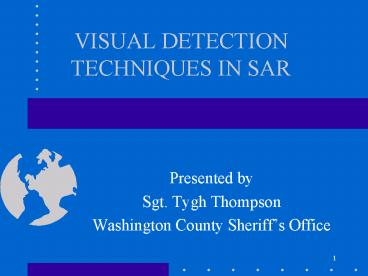VISUAL DETECTION TECHNIQUES IN SAR - PowerPoint PPT Presentation
1 / 28
Title:
VISUAL DETECTION TECHNIQUES IN SAR
Description:
THIS PROGRAM IS BASED ON RESEARCH COMPILED BY. DR. KENNETH HILL. HALIFAX REGIONAL SAR. NOVA SCOTIA, CANADA. 3. OVERVIEW. Introduction to the problem ... – PowerPoint PPT presentation
Number of Views:91
Avg rating:3.0/5.0
Title: VISUAL DETECTION TECHNIQUES IN SAR
1
VISUAL DETECTION TECHNIQUES IN SAR
- Presented by
- Sgt. Tygh Thompson
- Washington County Sheriffs Office
2
THIS PROGRAM IS BASED ON RESEARCH COMPILED BY
DR. KENNETH HILL HALIFAX REGIONAL SAR NOVA
SCOTIA, CANADA
3
OVERVIEW
- Introduction to the problem
- Seeing Vs. detecting
- Why clues are missed
- Visual search
- The Visual Briefing
4
THE LOST PERSON LEAVES CLUES
- At least 1300 tracks for every kilometer walked.
5
INTRODUCTION TO THE PROBLEM
- Why are so few clues detected?
- What can be done to increase visual detection?
6
SEEING Vs DETECTION
- Insert picture here
7
SEEING Vs DETECTION
8
SIGNAL DETECTION THEORY
- Perceptual judgement is based on a combination of
sensation and decision making processes - Stimulus event
- The eyes detect an item
- Neural activity
- The image is analyzed by the brain
9
SIGNAL DETECTION THEORY
- Comparison with personal standard
- The image is compared to what you think the item
should look like - Action or no action - decision
- Did the item meet my standard of what I am
looking for or is it important?
10
VISUAL PERSPECTIVE
- The clue must be in the center of focus or vision
- Edge detection occurs in the Fovea (center of the
Retina) - The eyes recognize the edges of items
- The sharper the image of the edge, the easier the
item is to detect - The most visual information is revealed in the
canonical or perfect perspective
11
VISUAL PERSPECTIVE
- How we may expect an item to appear
12
VISUAL PERSPECTIVE
- How we may expect an item to appear
13
VISUAL PERSPECTIVE
- How we may expect an item to appear
14
VISUAL PERSPECTIVE
How the item may appear in in the field
15
VISUAL PERSPECTIVE
- How the item may appear in in the field
16
VISUAL PERSPECTIVE
- How the item may appear in in the field
17
BARRIERS TO CLUE DETECTION
- Searchers underestimate the difficulty of the
task - They may confuse seeing with detecting
- They may expect clues to visually pop-out.
- Visual clues wont pop out unless there is
contrast such as edge definition
18
DETECTION IS DIFFICULT WHEN..
- The target is outside of central vision
- There is poor contrast in color and texture from
the targets background - Contours of the target are disguised or
camouflaged - The searcher does not have a good idea of what
the target looks like
19
CAMOUFLAGE
- The purpose of disruptive coloration (camouflage)
is not to prevent detection, but to delay it. - Loss of contrast and edges
20
THE SEARCH IMAGE
- A mental picture of the target
- Learned through perceptual experience
- May guide visual search
- What you expect or hope to see
21
DWELL TIME
- Defined as the length of time a searcher looks at
a specific spot - Affected by the searchers expectations
- Terminated by a decision that a target is not
there to be detected
22
THE VISUAL BRIEFING
- Face searchers away from the briefer
- Place assorted clues on the ground
- Have searchers detect them
- Then place them from different perspectives
23
SEARCHER EXPECTANCY
- The subjective probability of detecting a clue
- Affects scanning rate
- Affects follow-up inspections
- Affects dwell time
24
GOOD CLUES
- Are relatively large
- Have high contrast from their background
- Are familiar to the searcher
25
SEARCHING FOR MULTIPLE TARGETS
- Is more difficult than searching for a single
target or clue - Improves with practice
- Improves with printing
26
CONCLUSIONS
- Detecting a clue is much more difficult than just
seeing - The clue must be detected
- There are many more misses when people believe
there is a low probability of detecting a target - Form recognition occurs in central vision
27
CONCLUSIONS CONT.
- In a complex visual field, form is rarely
detected on the first pass - While scanning the searcher will have to return
their gaze back to the object in order to
perceive it. - The threshold for form recognition will depend
upon the match between the retinal image and what
the perceiver expects to see
28
CONCLUSIONS CONT.
- Forms are more difficult to recognize when
- They are outside of their usual context
- They are positioned differently from their ideal
perspective (canonical view) - The searcher does not have a clear idea of what
the object should look like (search image)































